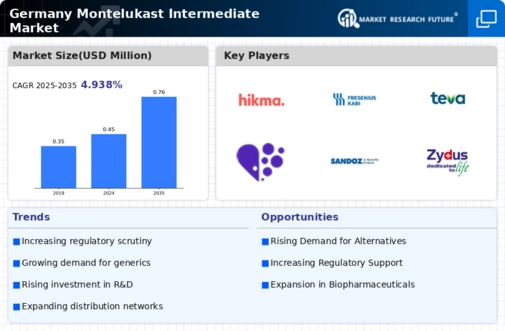Rising Healthcare Expenditure
The increasing healthcare expenditure in Germany is a significant driver for the montelukast intermediate market. As the government and private sectors allocate more funds towards healthcare services, there is a corresponding rise in the demand for effective treatments for respiratory conditions. Current estimates indicate that healthcare spending in Germany is projected to reach approximately €500 billion by 2025. This increase in expenditure is likely to enhance access to medications, including those containing montelukast intermediates. Consequently, pharmaceutical companies are expected to ramp up production to meet the anticipated demand, thereby propelling the growth of the montelukast intermediate market.
Regulatory Framework and Market Access
The regulatory framework governing the pharmaceutical industry in Germany plays a pivotal role in shaping the montelukast intermediate market. Stringent regulations ensure that all intermediates meet high-quality standards, which can be both a challenge and an opportunity for manufacturers. Compliance with these regulations is essential for market access, and companies that successfully navigate this landscape may gain a competitive edge. Moreover, the German Medicines Agency (BfArM) actively supports innovation while maintaining safety and efficacy standards. This regulatory environment encourages the development of montelukast intermediates, thereby fostering market growth and ensuring that patients have access to safe and effective treatments.
Advancements in Pharmaceutical Manufacturing
Technological advancements in pharmaceutical manufacturing processes are significantly impacting the montelukast intermediate market in Germany. Innovations such as continuous manufacturing and process optimization are enhancing production efficiency and reducing costs. For instance, the implementation of advanced analytical techniques has improved quality control measures, ensuring that montelukast intermediates meet stringent regulatory standards. This not only increases the reliability of the supply chain but also allows manufacturers to respond swiftly to market demands. As a result, the montelukast intermediate market is likely to benefit from these advancements, leading to increased production capacity and improved product availability for healthcare providers.
Increasing Prevalence of Allergic Conditions
The montelukast intermediate market in Germany is experiencing growth due to the rising prevalence of allergic conditions such as asthma and allergic rhinitis. Recent studies indicate that approximately 10-15% of the German population suffers from asthma, leading to a heightened demand for effective treatments. This trend is likely to drive the montelukast intermediate market as healthcare providers seek reliable solutions to manage these conditions. Furthermore, the increasing awareness of the importance of early intervention in allergic diseases may further bolster the market. As a result, pharmaceutical companies are focusing on the development and production of montelukast intermediates to meet the growing needs of healthcare professionals and patients alike.
Growing Investment in Research and Development
Investment in research and development (R&D) within the pharmaceutical sector is a crucial driver for the montelukast intermediate market in Germany. With a focus on developing new formulations and delivery methods, companies are allocating substantial resources to R&D initiatives. Reports suggest that R&D spending in the German pharmaceutical industry has reached approximately €10 billion annually, indicating a strong commitment to innovation. This investment is expected to yield new montelukast intermediates that can enhance therapeutic efficacy and patient compliance. Consequently, the montelukast intermediate market is poised for growth as new products emerge from these R&D efforts.




















Leave a Comment